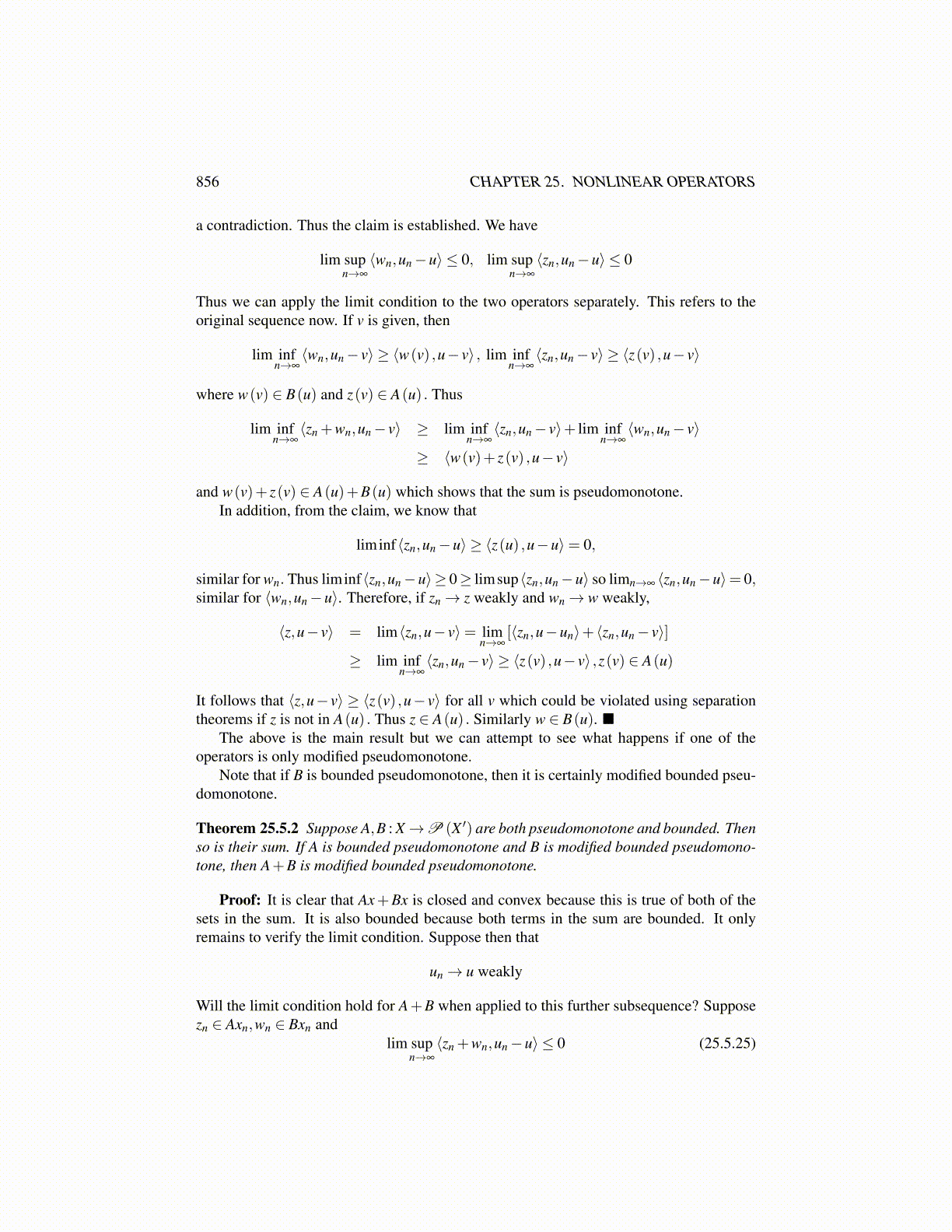
856 CHAPTER 25. NONLINEAR OPERATORS
a contradiction. Thus the claim is established. We have
lim supn→∞
⟨wn,un−u⟩ ≤ 0, lim supn→∞
⟨zn,un−u⟩ ≤ 0
Thus we can apply the limit condition to the two operators separately. This refers to theoriginal sequence now. If v is given, then
lim infn→∞⟨wn,un− v⟩ ≥ ⟨w(v) ,u− v⟩ , lim inf
n→∞⟨zn,un− v⟩ ≥ ⟨z(v) ,u− v⟩
where w(v) ∈ B(u) and z(v) ∈ A(u) . Thus
lim infn→∞⟨zn +wn,un− v⟩ ≥ lim inf
n→∞⟨zn,un− v⟩+ lim inf
n→∞⟨wn,un− v⟩
≥ ⟨w(v)+ z(v) ,u− v⟩
and w(v)+ z(v) ∈ A(u)+B(u) which shows that the sum is pseudomonotone.In addition, from the claim, we know that
liminf⟨zn,un−u⟩ ≥ ⟨z(u) ,u−u⟩= 0,
similar for wn. Thus liminf⟨zn,un−u⟩≥ 0≥ limsup⟨zn,un−u⟩ so limn→∞ ⟨zn,un−u⟩= 0,similar for ⟨wn,un−u⟩. Therefore, if zn→ z weakly and wn→ w weakly,
⟨z,u− v⟩ = lim⟨zn,u− v⟩= limn→∞
[⟨zn,u−un⟩+ ⟨zn,un− v⟩]
≥ lim infn→∞⟨zn,un− v⟩ ≥ ⟨z(v) ,u− v⟩ ,z(v) ∈ A(u)
It follows that ⟨z,u− v⟩ ≥ ⟨z(v) ,u− v⟩ for all v which could be violated using separationtheorems if z is not in A(u) . Thus z ∈ A(u) . Similarly w ∈ B(u).
The above is the main result but we can attempt to see what happens if one of theoperators is only modified pseudomonotone.
Note that if B is bounded pseudomonotone, then it is certainly modified bounded pseu-domonotone.
Theorem 25.5.2 Suppose A,B : X→P (X ′) are both pseudomonotone and bounded. Thenso is their sum. If A is bounded pseudomonotone and B is modified bounded pseudomono-tone, then A+B is modified bounded pseudomonotone.
Proof: It is clear that Ax+Bx is closed and convex because this is true of both of thesets in the sum. It is also bounded because both terms in the sum are bounded. It onlyremains to verify the limit condition. Suppose then that
un→ u weakly
Will the limit condition hold for A+B when applied to this further subsequence? Supposezn ∈ Axn,wn ∈ Bxn and
lim supn→∞
⟨zn +wn,un−u⟩ ≤ 0 (25.5.25)